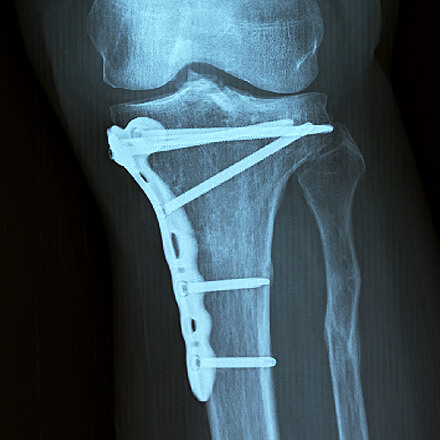Orthopedic care from sports medicine doctors
Treatments for sports-related injuries
Sports medicine is a medical specialization that focuses on preventing and treating sports and exercise-related injuries. Florida Orthopaedic Institute’s team of highly skilled physicians lead the largest and most advanced sports medicine program in the region.
Our sports medicine doctors have served as the team physicians for the Tampa Bay Buccaneers, Tampa Bay Inferno, Tampa Bay Lightning, Tampa Mayhem, Tampa Bay Mutiny, Tampa Bay Rowdies, Tampa Bay Storm, University of South Florida, University of Tampa, Saint Leo University and many high schools throughout Hillsborough and Pinellas Counties.






Learn more about
Sports medicine care team at FOI
Operative and non-operative physicians






























When should you seek an evaluation?
You should see a doctor for an injury when you:
- Have severe pain and cannot put any weight on the injured area.
- Have an area over or around the damaged joint that is very tender upon touch.
- Find that the injured area is altered in its shape or size as compared to the opposite side
- Can’t move the injured joint.
- See that the injured area looks crooked or has lumps and bumps, other than swelling.
- Can’t walk without feeling significant pain.
- Try to use the joint and it buckles or gives way.
- Have numbness in any part of the injured area.
- See redness or red streaks spreading out from the injury.
- Have pain, swelling, or redness over the injured area.
- Are in doubt about the seriousness of the damage or how to care for it.
If you are injured during a sporting event, seek the advice of your team physician.

Learn more about sports medicine by downloading our free booklet, “Our 10 Most Asked Sports Medicine Questions.”
“It was a nasty injury. I went into surgery quickly after that and am recovering quite well now. I do heavy weight lifting, a lot of plyo, and a lot of jumping rope. I turned pro in the fitness competition world, so I had a great outcome. I’ve been able to come back and have no issues with it whatsoever.” Angelike Norrie | Knee Reconstruction
Treatments from sports medicine doctors
Florida Orthopaedic Institute sports medicine surgeons are fellowship-trained in advanced arthroscopic and reconstructive techniques, including the following:
Through new advanced therapies, patients can take advantage of their own ability to heal by using healthy cells found naturally throughout the body. Research suggests that it is possible to use these to restore and repair damaged or aging cells. These therapies have shown promise in orthopedic medicine, burn treatment, nerve restoration and treatment of heart conditions, diabetes, multiple sclerosis and other diseases.
Another emerging technique is used to treat patients with the following musculoskeletal problems:
- Osteoarthritis
- Tendon strains and ruptures such as tennis elbow, hamstring strains, rotator cuff tears and Achilles tendon ruptures
- Ligament sprains and tears such as anterior cruciate ligament tears and ulnar collateral ligament sprains
Research studies and clinical practice have shown promise in these advanced therapies’ ability to relieve pain by promoting long lasting healing of musculoskeletal conditions. Additional therapeutic uses are being explored.
To provide the highest quality of care, FOI physicians use diagnostic imaging to assist in diagnosing and treating a sports injury. Sports medicine patients can have their diagnostic work done in the same facility as they receive orthopedic care at Florida Orthopaedic Institute. Our highly skilled healthcare professionals use the most advanced technology to meet every patient’s distinct medical needs.
There are many potential dangers posed by warm and humid weather, especially in Florida. Known in a category called heat injuries, they include heat prostration, heat syncope, heat exhaustion, and heatstroke.
Sometimes, heat injuries result in minor, easily correctable problems. In more serious cases, they can produce life-threatening complications.
Sports injuries can happen outside of the typical school day and workweek, which is when most practices and games are held. Florida Orthopaedic Institute offers an urgent care center that provides an alternative to overcrowded emergency rooms and centers that don’t specialize in bone and joint problems. Our Orthopedic Urgent Care location is open Monday through Saturday, with extended evening hours Monday through Thursday.
We understand your desire to get back into the game and will do everything we can to make that happen safely. Because of their dynamic nature, sports injuries require specialized methods of treatment. Our in-house physical and occupational therapy services are designed to support the rehabilitation needs of our patients, seamlessly integrating with the care provided by our orthopedic physicians.
Concussions are the most common of all traumatic brain injuries and often result from sports injuries, car accidents or falls. Symptoms can range from a mild headache, difficulty concentrating and amnesia, to complete loss of consciousness. At Florida Orthopaedic Institute, we offer the most scientifically validated computerized evaluation and specialized treatment for this type of injury. This helps ensure an appropriate time period prior to return to sports, and the lowest risk possible for repeated concussions or long-term problems.
Education & outreach
Research and education is at the forefront of the work we do. If you’re interested in having one of our sports medicine physicians speak to your school group, coaching staff, or organization please contact the Director of Customer Service and Marketing at (813) 978-9700.
We invite Certified Athletic Trainers and Board Certified, Sports Medicine orthopedic surgeons interested in volunteering their expertise and time to support athletes during practice, home games, and other community events to explore our Community Outreach Program.
Trusted athletic orthopedic provider







